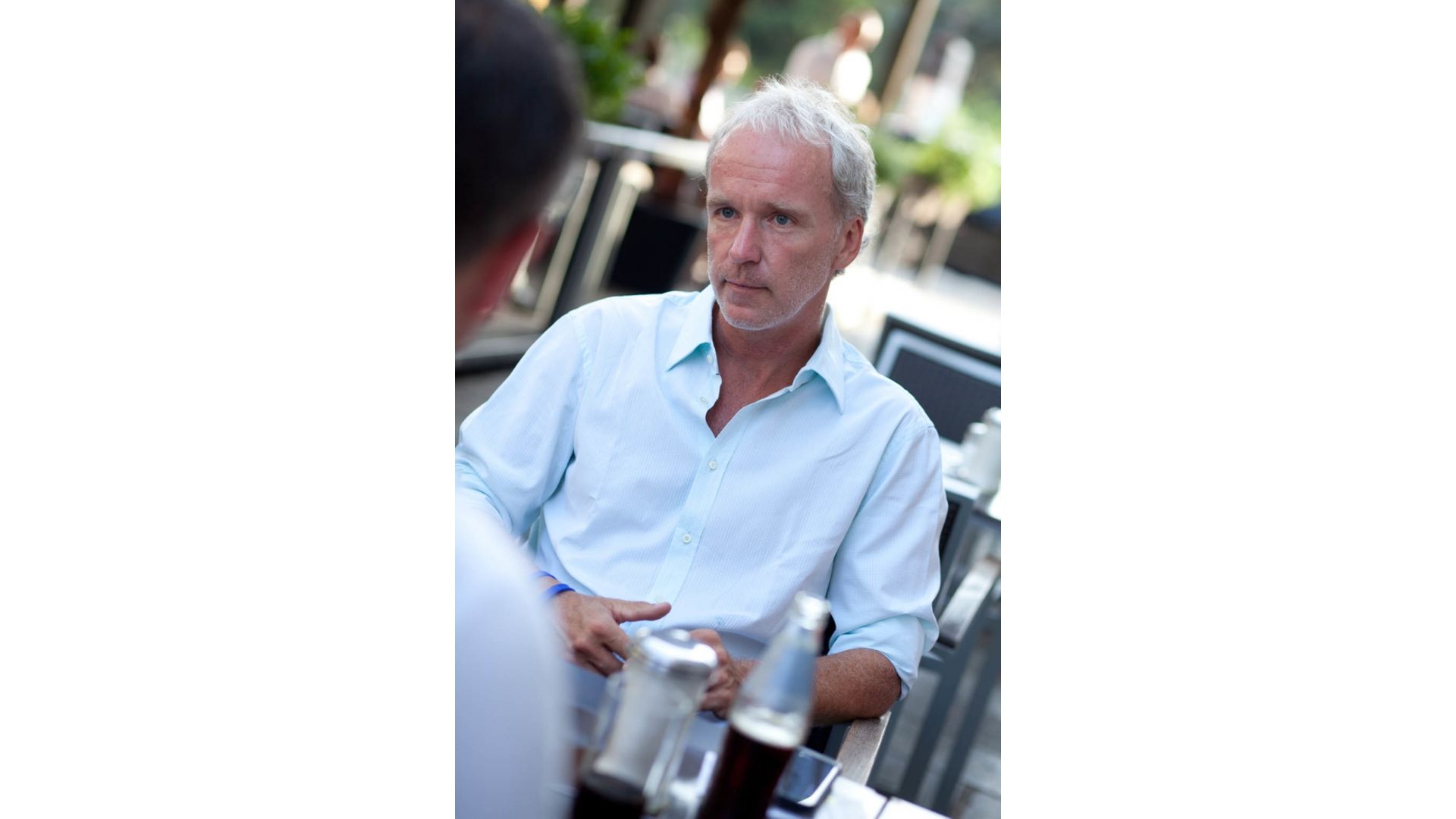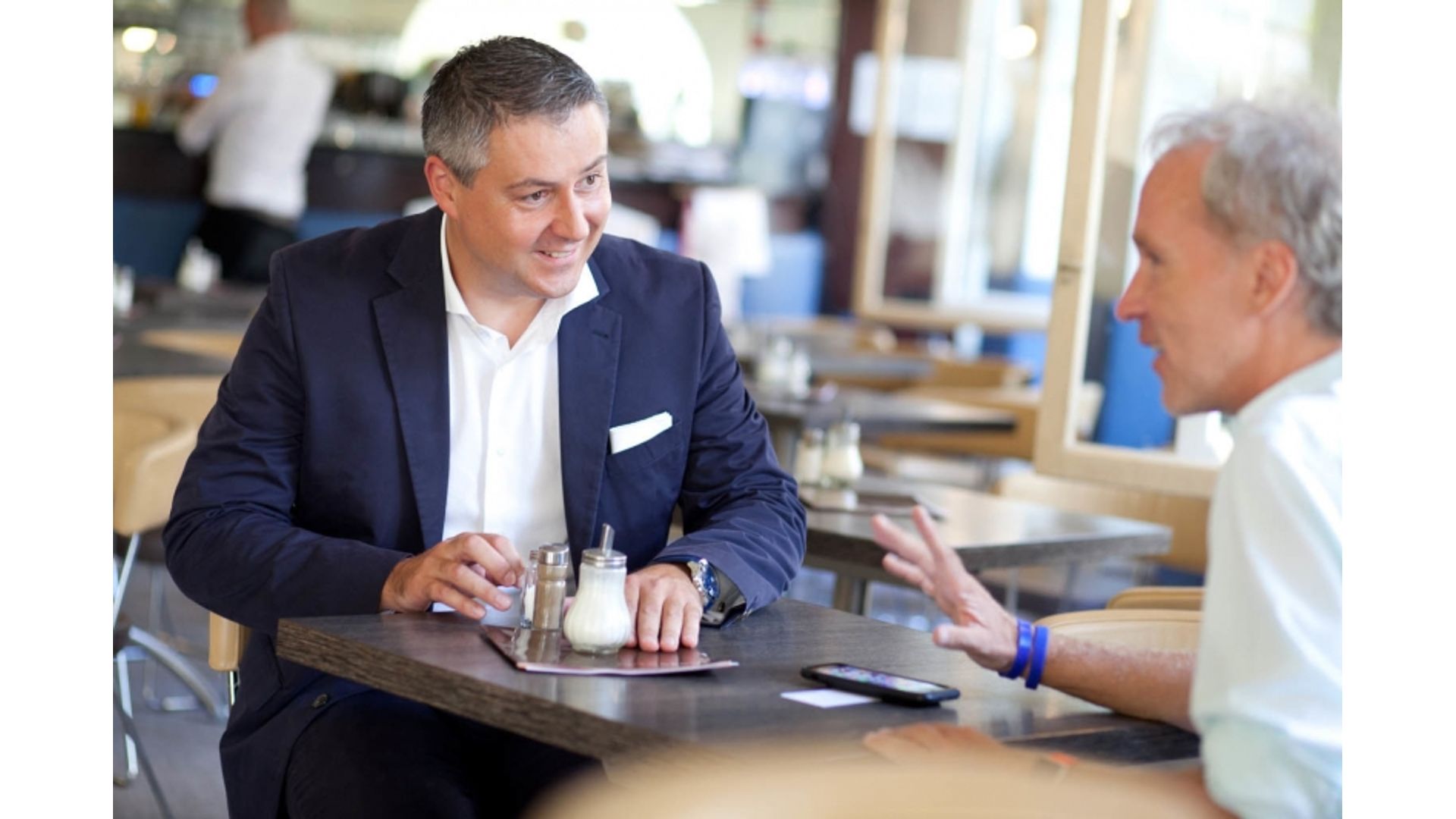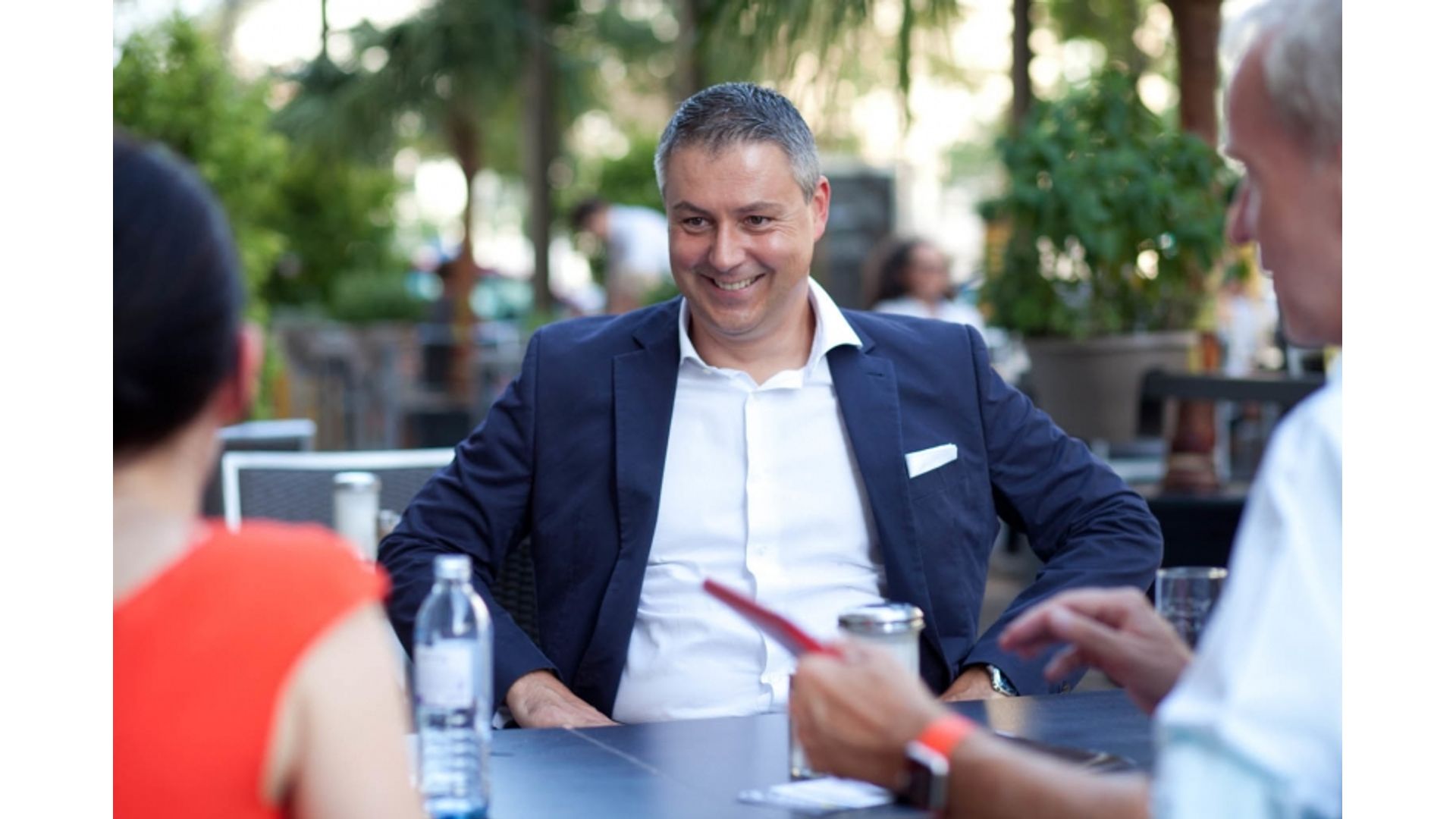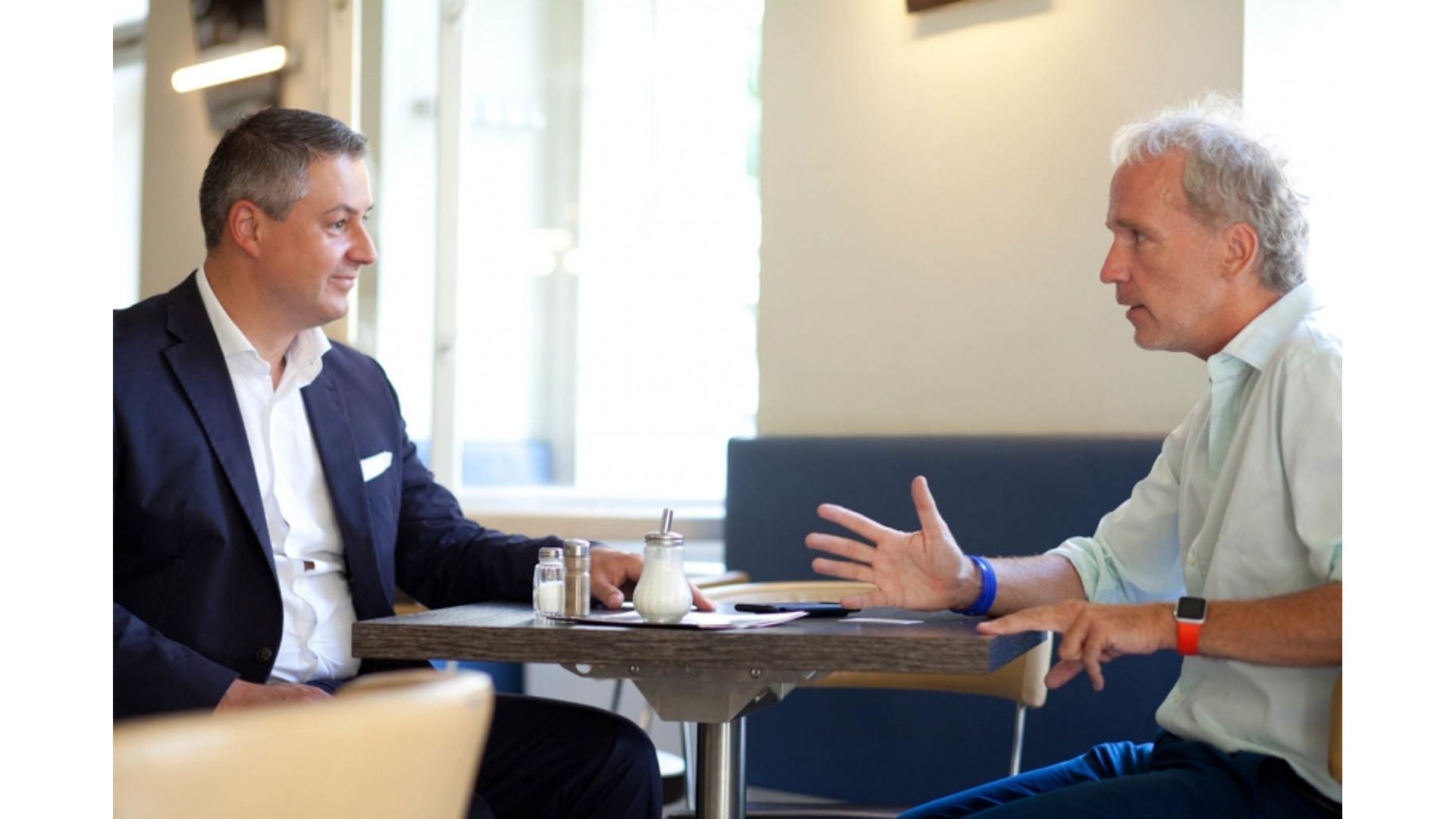
21.09.2017
Immofinanz CEO Oliver Schumy in an interview with the Börse Social Magazine on key issues like the comeback of the share, CA Immo and Russia
One of my last interviews this past summer was with Immofinanz CEO Oliver Schumy. At the Cafe Stein in Vienna we talked about key Immofinanz issues like the comeback of the share, CA Immo and Russia. He also explained what the real estate branch could learn from the industrial sector where he worked for many years, how order was created in the portfolio and the advantages Immofinanz and CA Immo could have together on the Eurobond market.
Info on our monthly 100-page print version can be found under http://www.boerse-social.com/magazine, and the interview in full length and in PDF form are included here:
Mr. Schumy: The IMMOFINANZ share followed several quarters at the bottom of the ATX with a shift to the fast lane this past summer. Year-to-date we have a plus of more than 20 per cent and, since the annual low, even more than 35 percent. You continued to pursue your strategy during difficult communication phases, delivered pretty strong numbers and the share has started to climb. Satisfied?
Oliver Schumy: We did our homework and want to move into the fast lane in the future. Starting conditions were not very good in recent years, but our positioning is now sound. There are still a number of things to do, but we are on the right course. And, as you can see, the market has recognised that we do what we say and has started to believe in our story.
Good. I would like to go into a few points in detail. You come from the industrial sector and were a member of the managing board at Mayr-Melnhof for many years. Do you see any developments that the real estate branch can take over from industrial companies?
Definitely, yes – the high degree of standardisation and economies of scale. In the industrial sector, for example, no one would ever think of developing new templates for the production of identical products and starting from zero time and time again. That, in contrast, is common practice in the real estate branch. In order to work more efficiently, we decided to focus our property portfolio on brands: myhive for offices plus Stop Shop and Vivo! for our retail properties. The strong standardisation of these products not only promises high recognition value for our tenants and customers, but also brings cost savings and significantly easier realisation.
An example for this standardisation?
Let’s take our myhive office brand, which is characterised, among others, by a friendly atmosphere just like a hotel lobby: Here we have defined exactly what materials, lounge furniture, lamps etc. are to be used. That means we don’t have to develop a modernisation plan and commission an architect for every office building, but can roll out a uniform concept. In the first phase, this roll-out covers 18 office buildings with nearly 450,000 sqm of space and a book value of almost one billion Euros.
Another example are our Stop Shop retail parks: We now have almost 70 locations in eight countries and are working on further development projects. Construction is based on one of three prototypes, with the arrangement in an I-form, L-form or U-form. Everything else is also precisely defined, from the building structure to the facade and signage. This detailed catalogue also has another advantage – with an average construction time of seven months, we are very fast in developing a new Stop Shop. At the same time, the investment costs are substantially lower than a shopping center. We have created a very profitable product with our Stop Shops – and here I mean a rental return of 7.5% and more – and we have great plans for the future.
What will this lead to? A new investment story?
Let me put it this way: We want to grow our Stop Shop portfolio to substantially more than 100 locations over the coming years. That would represent a property value of more than one billion Euros. And make us the leading retail park operator in the region. We are seeing rising interest and strong momentum in this segment, also on the part of our tenants. Retailers, who were only interested in inner city locations and large shopping centers a few years ago, are now becoming more interested in our concept. What benefits can we offer: Our Stop Shops allow for fast growth in regions that are not yet saturated. And that at comparatively low rent.
Amazon has led to a decline in the market value of numerous established retail giants. Any worries over online retailing?
Of course, that’s an important factor which must be addressed. But our Stop Shops have virtually no overlaps with the Internet. Our retail parks are concentrated on things people need every day and are, so to say, appealing shops right around the corner. In addition, our retail parks are an addition to the click & collect offers by many retailers. Our locations are decentralised in smaller and medium-sized cities, meaning close to customers. That helps to address the declining interest in mobility by many shoppers.
Since your appointment as CEO in May 2015, you have not only refocused the portfolio. When you look back, what was your greatest challenge?
Roughly two years ago, the interest of many investors in our company and what it does was relatively limited and the mood was rather subdued. The situation in Russia added to this feeling. We then got to work to make the company fit for the future and to create a perspective beyond the next few years. Today we can see: It works, even though we still have a number of things to do. We have significantly strengthened the company and again made it attractive for investors. Creating this attractiveness was a central goal.
We also created order in the portfolio and, in doing so, worked consequently on its concentration and optimisation. The product “real estate“ was shifted to the foreground and we addressed, and in the end significantly improved, the rather modest occupancy rate. That was one of my main concerns. In the office sector, we raised our occupancy rate from about 75% to over 90% in two and a half years. The overall portfolio rate started at roughly 84% and is now close to 93%. Which is an absolute top value in the real estate industry.
Another important assignment was to improve our credit profile and cut our financing costs. We succeeded here, and also made the organisation leaner and more efficient. And last but not least, it was also important to discard the rucksack of historical lawsuits by investors and other legal disputes. That has also been completed. In short: We concentrated on the areas which differentiate IMMOFINANZ from its competitors and can now finally present ourselves to the market under the same conditions. We have done our homework and now want to move over to the fast lane.
This has already been recognised in part on the stock exchange. But the fast lane would also include your plans with CA Immo. Together you would be one of the top five or six players in Continental Europe. Is size really that important in the real estate business?
Yes, size is playing an increasingly important role. Two factors, above all, are decisive here. On the one hand, costs: Take a look at the construction cost index, for example in Germany. The development costs for office and retail properties have risen by 16% since 2010. That means construction costs are a growing share of the total investment volume. And a company must be able to carry this. On the other hand, strict regulation – keyword Basel IV – has led the banks to further reduce their financing volumes in the real estate sector. A large player who can obtain favourably priced refinancing on the Eurobond market in this environment has clear competitive advantages. Take a look at Unibail Rodamco. In a single transaction, the group raises between 500 million and one billion euros on the bond market – and that at conditions near 1.5%. There are a lot of potential savings here.
And neither IMMOFINANZ nor CA Immo can play in this league at the present time?
The two companies alone are much too small. Together it would work.
On the project pipeline: Could it be realised faster together?
Yes, of course. That’s true, above all, for CA Immo with its extensive land reserves in the major German cities and in the currently very good market environment. IMMOFINANZ has also developed a profitable and very attractive portfolio in Germany, which is now approaching completion. Our first project with RWTH Aachen University has already been transferred to the tenants, and the new headquarters for trivago and Uniper in the Düsseldorf Medienhafen will be completed next year. These are all very clearly structured and solid projects.
Let’s go back briefly to IMMOFINANZ’s financing: You restructured a number of things. Satisfied?
Yes, without a doubt. We substantially reduced the volume of bonds with historically high interest rates and sharply cut our financing costs. Roughly two and a half years ago the company had roughly one billion Euros of bonds outstanding, which were scheduled to mature in the years up to 2018. Included here were bonds with very high interest rates of 5.25% and 4.75%. We resolved this situation in a number of steps and, with our recent refinancing at the beginning of 2017, reduced interest costs over the medium-term by 21 million Euros per year. Our convertible bond 2018, which still has a volume of nearly 300 million Euros and a term ending in 2018, is now in the money. That means rational investors can be expected to choose conversion. We will then have only one convertible bond outstanding: We issued it this year in January with a volume of nearly 300 million Euros – the coupon equals 2% and will drop to 1.5% as soon as we receive a rating.
In other words, you want a rating ...
Yes, that is also on our list. And in the past years, we eliminated a number of hurdles that would stand in the way of an investment grade rating. As soon as we have separated our Moscow portfolio, we intend to start the rating process.
You mean the historical legal disputes with investors?
Yes, on the one hand, the termination of these issues, which initially had a value in dispute of more than 300 million Euros. But also the reduction of our loan-to-value ratio, meaning our debt financing in relation to the book value of our properties. We were at 46% by the end of June, down from nearly 50% at year-end 2016. And if you assume our convertible bond 2018 will be converted into equity in March 2018, our LTV would be 41.5%.
On the ongoing issue of Russia: Is the separation of the Russian properties a condition for the merger or not? Who actually specified this condition?
It was our decision, which we announced together with the purchase of a 26% investment in CA Immo. What was behind this? Russia has a completely different risk profile than the rest of our portfolio – and the political risk seen by investors in this country has increased substantially. You can earn a lot in Russia for a number of years, but politics can change completely from one day to the next. That’s not the case in the EU or in our core markets. For that reason, IMMOFINANZ is no longer the best owner for these shopping centers. Our investors share this opinion, and immediately eliminated our Russian properties from our market valuation when the crisis started.
You were also confronted with wishes from so-called “activist investors“. How do you deal with this?
Offensively. I maintain regular and intensive contacts with our investors. As a matter of fact, I had an appointment with several private investors shortly before our meeting today.
In conclusion: Where do you see the group in three years?
As one of the largest players on the commercial property market in Europe with a clear focus on its brands and high appeal for its shareholders.
Info on our monthly 100-page print version can be found under http://www.boerse-social.com/magazine, and the interview in full length and in PDF form are included here:
Mr. Schumy: The IMMOFINANZ share followed several quarters at the bottom of the ATX with a shift to the fast lane this past summer. Year-to-date we have a plus of more than 20 per cent and, since the annual low, even more than 35 percent. You continued to pursue your strategy during difficult communication phases, delivered pretty strong numbers and the share has started to climb. Satisfied?
Oliver Schumy: We did our homework and want to move into the fast lane in the future. Starting conditions were not very good in recent years, but our positioning is now sound. There are still a number of things to do, but we are on the right course. And, as you can see, the market has recognised that we do what we say and has started to believe in our story.
Good. I would like to go into a few points in detail. You come from the industrial sector and were a member of the managing board at Mayr-Melnhof for many years. Do you see any developments that the real estate branch can take over from industrial companies?
Definitely, yes – the high degree of standardisation and economies of scale. In the industrial sector, for example, no one would ever think of developing new templates for the production of identical products and starting from zero time and time again. That, in contrast, is common practice in the real estate branch. In order to work more efficiently, we decided to focus our property portfolio on brands: myhive for offices plus Stop Shop and Vivo! for our retail properties. The strong standardisation of these products not only promises high recognition value for our tenants and customers, but also brings cost savings and significantly easier realisation.
An example for this standardisation?
Let’s take our myhive office brand, which is characterised, among others, by a friendly atmosphere just like a hotel lobby: Here we have defined exactly what materials, lounge furniture, lamps etc. are to be used. That means we don’t have to develop a modernisation plan and commission an architect for every office building, but can roll out a uniform concept. In the first phase, this roll-out covers 18 office buildings with nearly 450,000 sqm of space and a book value of almost one billion Euros.
Another example are our Stop Shop retail parks: We now have almost 70 locations in eight countries and are working on further development projects. Construction is based on one of three prototypes, with the arrangement in an I-form, L-form or U-form. Everything else is also precisely defined, from the building structure to the facade and signage. This detailed catalogue also has another advantage – with an average construction time of seven months, we are very fast in developing a new Stop Shop. At the same time, the investment costs are substantially lower than a shopping center. We have created a very profitable product with our Stop Shops – and here I mean a rental return of 7.5% and more – and we have great plans for the future.
What will this lead to? A new investment story?
Let me put it this way: We want to grow our Stop Shop portfolio to substantially more than 100 locations over the coming years. That would represent a property value of more than one billion Euros. And make us the leading retail park operator in the region. We are seeing rising interest and strong momentum in this segment, also on the part of our tenants. Retailers, who were only interested in inner city locations and large shopping centers a few years ago, are now becoming more interested in our concept. What benefits can we offer: Our Stop Shops allow for fast growth in regions that are not yet saturated. And that at comparatively low rent.
Amazon has led to a decline in the market value of numerous established retail giants. Any worries over online retailing?
Of course, that’s an important factor which must be addressed. But our Stop Shops have virtually no overlaps with the Internet. Our retail parks are concentrated on things people need every day and are, so to say, appealing shops right around the corner. In addition, our retail parks are an addition to the click & collect offers by many retailers. Our locations are decentralised in smaller and medium-sized cities, meaning close to customers. That helps to address the declining interest in mobility by many shoppers.
Since your appointment as CEO in May 2015, you have not only refocused the portfolio. When you look back, what was your greatest challenge?
Roughly two years ago, the interest of many investors in our company and what it does was relatively limited and the mood was rather subdued. The situation in Russia added to this feeling. We then got to work to make the company fit for the future and to create a perspective beyond the next few years. Today we can see: It works, even though we still have a number of things to do. We have significantly strengthened the company and again made it attractive for investors. Creating this attractiveness was a central goal.
We also created order in the portfolio and, in doing so, worked consequently on its concentration and optimisation. The product “real estate“ was shifted to the foreground and we addressed, and in the end significantly improved, the rather modest occupancy rate. That was one of my main concerns. In the office sector, we raised our occupancy rate from about 75% to over 90% in two and a half years. The overall portfolio rate started at roughly 84% and is now close to 93%. Which is an absolute top value in the real estate industry.
Another important assignment was to improve our credit profile and cut our financing costs. We succeeded here, and also made the organisation leaner and more efficient. And last but not least, it was also important to discard the rucksack of historical lawsuits by investors and other legal disputes. That has also been completed. In short: We concentrated on the areas which differentiate IMMOFINANZ from its competitors and can now finally present ourselves to the market under the same conditions. We have done our homework and now want to move over to the fast lane.
This has already been recognised in part on the stock exchange. But the fast lane would also include your plans with CA Immo. Together you would be one of the top five or six players in Continental Europe. Is size really that important in the real estate business?
Yes, size is playing an increasingly important role. Two factors, above all, are decisive here. On the one hand, costs: Take a look at the construction cost index, for example in Germany. The development costs for office and retail properties have risen by 16% since 2010. That means construction costs are a growing share of the total investment volume. And a company must be able to carry this. On the other hand, strict regulation – keyword Basel IV – has led the banks to further reduce their financing volumes in the real estate sector. A large player who can obtain favourably priced refinancing on the Eurobond market in this environment has clear competitive advantages. Take a look at Unibail Rodamco. In a single transaction, the group raises between 500 million and one billion euros on the bond market – and that at conditions near 1.5%. There are a lot of potential savings here.
And neither IMMOFINANZ nor CA Immo can play in this league at the present time?
The two companies alone are much too small. Together it would work.
On the project pipeline: Could it be realised faster together?
Yes, of course. That’s true, above all, for CA Immo with its extensive land reserves in the major German cities and in the currently very good market environment. IMMOFINANZ has also developed a profitable and very attractive portfolio in Germany, which is now approaching completion. Our first project with RWTH Aachen University has already been transferred to the tenants, and the new headquarters for trivago and Uniper in the Düsseldorf Medienhafen will be completed next year. These are all very clearly structured and solid projects.
Let’s go back briefly to IMMOFINANZ’s financing: You restructured a number of things. Satisfied?
Yes, without a doubt. We substantially reduced the volume of bonds with historically high interest rates and sharply cut our financing costs. Roughly two and a half years ago the company had roughly one billion Euros of bonds outstanding, which were scheduled to mature in the years up to 2018. Included here were bonds with very high interest rates of 5.25% and 4.75%. We resolved this situation in a number of steps and, with our recent refinancing at the beginning of 2017, reduced interest costs over the medium-term by 21 million Euros per year. Our convertible bond 2018, which still has a volume of nearly 300 million Euros and a term ending in 2018, is now in the money. That means rational investors can be expected to choose conversion. We will then have only one convertible bond outstanding: We issued it this year in January with a volume of nearly 300 million Euros – the coupon equals 2% and will drop to 1.5% as soon as we receive a rating.
In other words, you want a rating ...
Yes, that is also on our list. And in the past years, we eliminated a number of hurdles that would stand in the way of an investment grade rating. As soon as we have separated our Moscow portfolio, we intend to start the rating process.
You mean the historical legal disputes with investors?
Yes, on the one hand, the termination of these issues, which initially had a value in dispute of more than 300 million Euros. But also the reduction of our loan-to-value ratio, meaning our debt financing in relation to the book value of our properties. We were at 46% by the end of June, down from nearly 50% at year-end 2016. And if you assume our convertible bond 2018 will be converted into equity in March 2018, our LTV would be 41.5%.
On the ongoing issue of Russia: Is the separation of the Russian properties a condition for the merger or not? Who actually specified this condition?
It was our decision, which we announced together with the purchase of a 26% investment in CA Immo. What was behind this? Russia has a completely different risk profile than the rest of our portfolio – and the political risk seen by investors in this country has increased substantially. You can earn a lot in Russia for a number of years, but politics can change completely from one day to the next. That’s not the case in the EU or in our core markets. For that reason, IMMOFINANZ is no longer the best owner for these shopping centers. Our investors share this opinion, and immediately eliminated our Russian properties from our market valuation when the crisis started.
You were also confronted with wishes from so-called “activist investors“. How do you deal with this?
Offensively. I maintain regular and intensive contacts with our investors. As a matter of fact, I had an appointment with several private investors shortly before our meeting today.
In conclusion: Where do you see the group in three years?
As one of the largest players on the commercial property market in Europe with a clear focus on its brands and high appeal for its shareholders.





